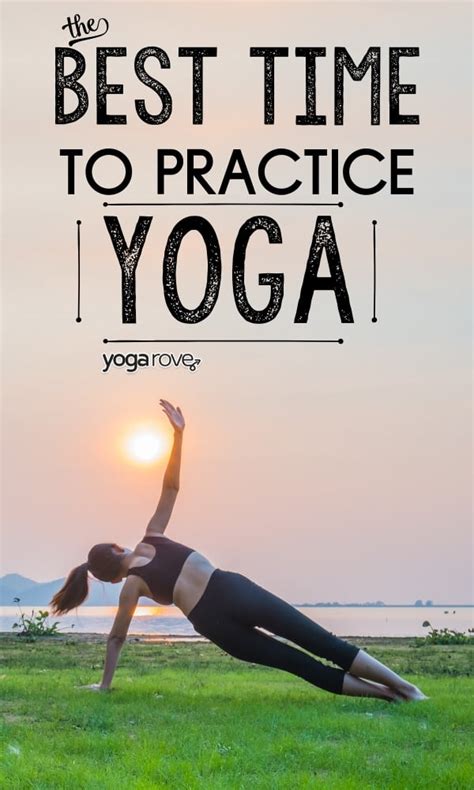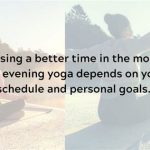The Best Time to Practice Yoga: Discover the Optimal Moments for Your Routine
Yoga is a transformative practice that not only enhances physical flexibility but also nurtures mental clarity and emotional balance. But when is the best time to practice yoga? The answer depends on a variety of factors, from individual preferences to scientific rhythms that guide our body’s performance. In this article, we explore the different perspectives, historical traditions, modern science, and practical applications surrounding the ideal times to practice yoga. By the end, you’ll have a clear understanding of what might work best for you.
Introduction: The Timeless Question of Yoga Timing
The practice of yoga has spanned centuries, with ancient yogis adhering to specific schedules that aligned with nature’s rhythms. In contrast, today’s fast-paced world often necessitates flexibility in routines. While the early morning is traditionally considered ideal, modern practitioners must balance work, family, and other responsibilities. So, does timing really matter? Can you gain the same benefits from yoga whether it’s performed at sunrise or sunset? This article delves into these questions and offers evidence-backed guidance to help you determine the best time for your yoga practice.
Key Concepts: The Science and Tradition Behind Yoga Timing
- Circadian Rhythms: The natural cycle of physical, mental, and behavioral changes in our bodies, which are primarily influenced by light and darkness.
- Prana: According to yoga philosophy, prana is the vital life force that flows through the body, most abundant during specific times of day.
- Agni: The body’s internal fire, which yogic texts suggest is strongest during mid-day, promoting digestion and energy.
Ancient traditions and modern science agree that our bodies follow natural rhythms that influence physical performance, focus, and energy levels. Understanding these rhythms can help determine the most effective time for your yoga practice.
Historical Context: Traditional Perspectives on Yoga Timing
In traditional yoga practices, the timing of your routine is closely linked to nature. The two key periods emphasized by ancient texts like the Hatha Yoga Pradipika are Brahma Muhurta (around 4:00–6:00 AM) and the evening, around sunset. Both are seen as ideal times when prana is most active and the mind is naturally calm.
Historically, practicing at these times was more accessible for individuals who lived by nature’s rhythms—such as farmers and hermits. Today’s fast-paced, urban lifestyles make this adherence less practical for many. However, the historical emphasis on these times provides insight into how yoga’s founders perceived the interaction between our bodies and the natural world.
Current State Analysis: The Modern Perspective on Yoga Timing
In modern life, many factors influence when we practice yoga, including job schedules, family obligations, and personal energy levels. But science offers intriguing insights into the benefits of various times for physical activity, including yoga.
Morning Yoga
Benefits: Research suggests that practicing yoga early in the morning can improve focus, reduce stress, and set a positive tone for the day. Early morning is when cortisol, the body’s wake-up hormone, peaks. This creates a natural energy boost, making it easier to engage in physical activities.
Challenges: If you’re not a morning person, early practice may feel sluggish, and your muscles might be stiffer, increasing the risk of injury. However, slow, gentle poses can help loosen the body before a more intense practice.
Afternoon or Midday Yoga
Benefits: Practicing yoga in the afternoon, when body temperature peaks, may enhance flexibility and reduce the risk of injury. Midday is also when digestion (or agni) is strongest, providing the energy necessary for more dynamic practices.
Challenges: Midday practices can be hard to schedule due to work or other commitments. Additionally, heavy meals during lunch might make yoga uncomfortable or sluggish.
Evening Yoga
Benefits: Yoga in the evening can help relax your body and mind after a long day. It’s an excellent time for slow, restorative poses or deep stretching. Evening yoga can improve sleep quality, decrease stress, and encourage mindfulness.
Challenges: For those with high energy in the evening, calming down can be difficult, making it hard to wind down before bed. A practice that is too vigorous might also interfere with sleep.
Practical Applications: Tailoring Yoga to Fit Your Lifestyle
Given the demands of modern life, flexibility is key in designing your yoga routine. Whether you’re an early bird or a night owl, yoga can be adapted to suit your needs. Here’s a practical guide based on personal and professional obligations:
| Time of Day | Best for | Recommended Practice |
|---|---|---|
| Early Morning (4-6 AM) | Focused individuals, those seeking meditation or light stretching | Pranayama (breathing exercises), gentle asanas, and meditation |
| Morning (6-9 AM) | Active individuals with daily obligations | Vinyasa flow, Surya Namaskar (sun salutations), strength-based poses |
| Midday (12-2 PM) | Flexible schedules, seeking energy boost or flexibility | Power yoga, dynamic flow, backbends, inversions |
| Evening (5-7 PM) | Relaxation seekers, stress relief after work | Restorative yoga, Yin yoga, long-hold stretches |
| Late Night (8-10 PM) | Insomniacs, those looking to calm the mind | Gentle stretching, pranayama, Nidra (yogic sleep) |
Case Studies: Real-World Experiences with Yoga Timing
Numerous studies and anecdotal evidence illustrate the varying benefits of different yoga schedules. For example, a 2020 study published in the Journal of Physiological Science found that morning yoga practitioners reported better mental focus, while evening practitioners highlighted the calming effects on their stress levels.
Case Study 1: Early Morning Practitioner
Sarah, a 35-year-old software engineer, found that practicing yoga at 5 AM before work helped her maintain a calm and focused demeanor throughout her day. She reported feeling less overwhelmed by work stress and experiencing better sleep at night.
Case Study 2: Evening Practitioner
John, a 42-year-old marketing executive, struggled with insomnia for years. He began practicing Yin yoga at 7 PM as part of his evening routine. Within a few weeks, John noticed a marked improvement in his sleep patterns and reduced anxiety.
Stakeholder Analysis: Who Benefits from Different Yoga Times?
The timing of yoga practice doesn’t just affect the individual; it also influences various stakeholders in the wellness industry, such as yoga instructors, studios, and online platforms. Morning and evening classes are typically the most popular, given people’s work schedules. Online platforms, however, offer flexibility for users who want to practice during off-peak times like midday.
Instructors: Need to understand their students’ varying energy levels and tailor classes accordingly.
Studios: Must balance offering both high-energy and calming sessions throughout the day to cater to different preferences.
Online Platforms: Benefit from offering on-demand classes to accommodate practitioners at any time.
Implementation Guidelines: Creating a Personalized Yoga Schedule
- Identify Your Goals: Whether you’re aiming for relaxation, energy, or flexibility, your goals should influence your practice time.
- Track Your Energy Levels: Keep a journal of when you feel most energetic or tired throughout the day. This can help you pinpoint the best times for yoga.
- Start Small: If you’re not sure when to practice, experiment with different times over a week and track how you feel.
Ethical Considerations: Respecting Individual Needs and Cultural Traditions
While yoga is a personal journey, practitioners must remain mindful of the cultural and spiritual roots of the practice. Respect for the traditional timing of yoga and its underlying philosophies, while not mandatory for every practitioner, contributes to a holistic understanding of the practice. Additionally, instructors must be cautious not to impose rigid schedules that conflict with students’ needs or preferences.
Limitations and Future Research: Exploring the Boundaries of Yoga Timing
There are still gaps in research regarding the best time for yoga, especially concerning diverse populations. Future research could examine the long-term effects of yoga at different times of the day across various demographics, such as older adults, shift workers, and people with chronic illnesses.
Additionally, most current studies focus on either morning or evening yoga. Expanding research to include midday and late-night practices could offer more comprehensive insights. The role of diet, sleep patterns, and external factors like stress should also be integrated into future studies to provide a more nuanced understanding of how yoga timing influences well-being.
Expert Commentary: Diverse Perspectives on Yoga Timing
Dr. Susan Patel, Circadian Rhythm Specialist: “Understanding your body’s internal clock can significantly optimize the benefits of yoga. For many, practicing at the wrong time can feel like swimming upstream—choosing the right time for your personal energy flow can make all the difference.”
Lisa Gonzalez, Yoga Instructor: “I’ve seen students transform their practice just by shifting their timing. Whether it’s morning to boost energy or evening to unwind, finding the sweet spot for your personal rhythm is essential.”
Michael Davies, Physical Therapist: “From a physical standpoint, practicing yoga when your body is most flexible and warmed up can help reduce injury risk. This typically happens in the late morning or early afternoon.”








